Delhi: C
This is a collection of articles archived for the excellence of their content. |
Chiragh Dilli
The Times of India, October 4, 2015
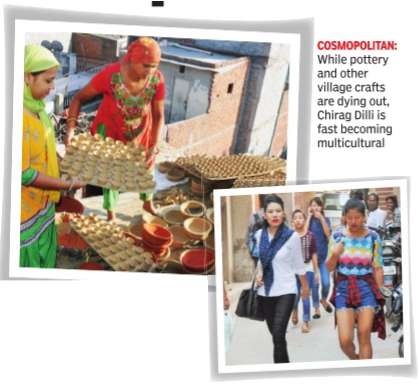

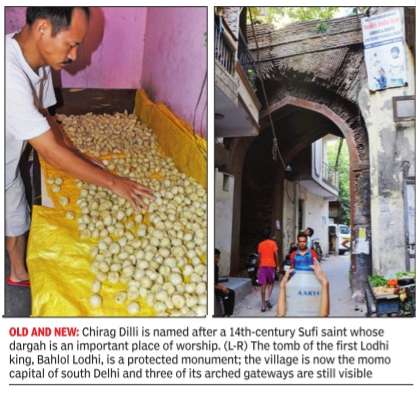
Richi Verma & Risha Chitlangia
One of the oldest villages in Delhi--it is named after the Sufi successor of HazratNizamuddinAuliya whose dargah is an important place of worship for all communities--Chirag Dilli has grown explosively over the past two decades. Its south Delhi location makes it attractive for workers on tight budgets.
While the flood of settlers has made the village a more vibrant place, old-timers worry their culture is under siege. And rapid unplanned construction has stretched the available infrastructure to breaking point.Besides the dargah of HazratNaseeruddin Mahmud Roshan Chirag Dilli, the village houses the tomb of the first Lodhi sultan, BahlolLodhi, about a dozen unprotected gumbads or domed monuments and four old gateways, one of which has been absorbed into the new buildings.
Momos
Culturally, people from the Northeast have had the most visible impact on Chirag Dilli. Thanks to them, momos are as popular as samosas among the village youth.The village is also south Delhi's momo factory, supplying to areas like Lajpat Nagar, South Extension, HauzKhas, Green Park and Malviya Nagar. But where the momo has caught on, a traditional craft like pottery is fading out.
Pottery
Only two families in KumharonkiGali still make pottery. Bimla's son, Rajinder, started learning the trade when he was five. Now 35 years old, he helps her continue the trade along with his wife. But Bimla says the returns don't justify the effort. “We earn just enough to make ends meet,“ she said. A trolley-load of clay costs Rs 10,000. “No one sees our hard work. It takes 3-4 days to make a batch of diyas and a week to complete big pots. But we get just Rs 2-3 for a diya,“ said Rajinder. Four storeys up a narrow, cracked staircase, 65-year old Bimla makes clay diyas, karwas and kulhads (earthen cups) from dawn to dusk for the festive season. She has a small kiln on her tiny, cluttered terrace in KumharonkiGali--now a potters' street in name only--and below it Chirag Dilli village spreads on all sides like a maze.
Gateways
Chirag Dilli has taken change in its stride and remains proud of its heritage. The original residents as well as the settlers know about the four gateways. “No one cares to do anything about these gateways although they are the identity of the village. Even ASI, which protects BahlolLodhi's tomb, is unable to stop encroachments around the building. All the gateways are crying for maintenance.
Bahlol Khan Lodhi's tomb
The Times of India, Aug 25 2015
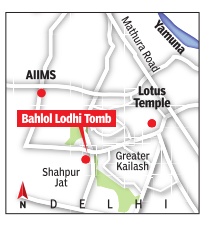
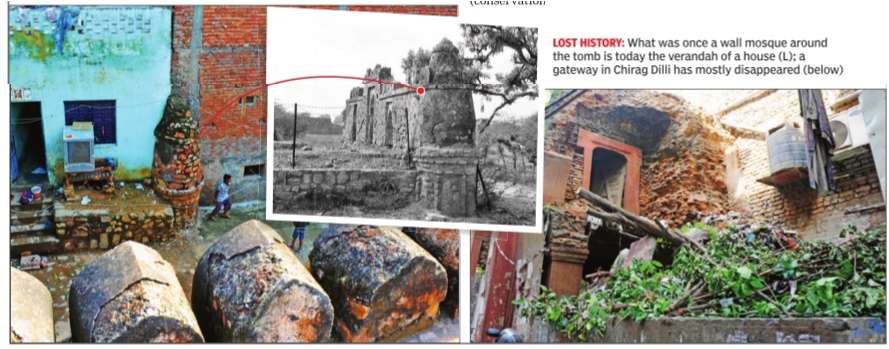
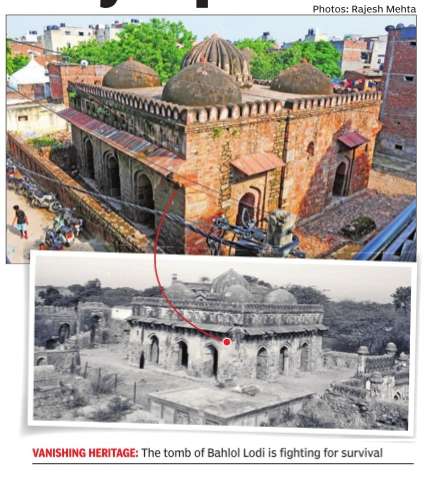
Richi Verma
A usurper Sultan's final resting place swallowed by squatters
As the founder of the Lodhi dynasty in Delhi, Bahlol Khan Lodhi left behind a lasting legacy . Yet his tomb today is in a shambles thanks to encroachments and lack of conservation efforts by authorities concerned. New buildings have come up around the monument in south Delhi's Chirag Dilli village, which itself is falling to pieces. Some portions, including a wall mosque surrounding it, vanished through the years and only the remnants are visible now. Bahlol Lodhi ruled Delhi from 1451 to 1488. History has it that he usurped the throne from the last of the Sayyid ruler. After his death, his tomb was said to have been built by his successor and son Sikander Lodhi. It used to be surrounded by a vast garden, which too has disappeared over the years.
A signage declaring Bahlol Lodhi's tomb a protected monument by Archaeological Survey of India (ASI) has failed to deter encroachers.One has to walk along a narrow lane amid multi-storey buildings to reach the monument. This is a place where residents seem to be fight ing for every inch of open space. Adjacent buildings have eaten into the monument's space with only the front part remaining protected due to the iron fencing installed by ASI. Children play on the grounds, teenagers come here for loitering around and women use the iron railing to dry their laundry.
It is unclear when the tomb last saw any conservation though patches of white plaster work can be seen at many points. Structurally, the monument is in a good state, but its overall condition is far from satisfactory with plaster peeling off from all sides and cracks developing on the façade. The five domes on the roof show decades of neglect as well. This might be the only protected monument in Chirag Dilli village. Besides, TOI could find only one gateway , which too is heavily encroached upon, among the four that existed in the same area.
In the main tomb, Quranic verses inscribed on the arches have all but vanished with the passage of time. “The quranic verses were important as these were the only ornamentation work in the whole structure,“ says an expert. ASI's director (conservation) Janhwij Sharma did not reply to TOI's queries on the conservation status of the tomb.ASI sources said constructions had come up prior to the monument being notified in the gazette. However, they said plans were afoot to start repair work.
Coronation Park
Anuja Jaiswal, Sep 13, 2022: The Times of India
NEW DELHI: The canopy at the India Gate complex now proudly houses the statue of Netaji Subhas Chandra Bose. King George V, the emperor for whom the stretch to Viceroy’s House was named Kingsway and which now is Kartavya Path, was long ousted from that lofty perch.
His statue had been removed to Coronation Park, the site of the grand durbar where George V and his wife were crowned imperial rulers of India in 1911. Over time, the park has become the neglected graveyard of the colonial statuary of monarchs and viceroys.
Except for the statue of George V, identified as such by a marker, the others have no signage. According to old reports, the stony visages there are of viceroys Lord Hardinge, Lord Willingdon, Lord Irwin and Lord Chelmsford. One of the five statues is so badly marred as to have lost all its features.
The park complex houses the Coronation Pillar — a memorial obelisk — and the five statues mounted on pedestals. The 55-acre park was supposed to be redeveloped by 2011 as a historical tourist spot with an interpretation centre, but that plan is far from complete. In fact, an amphitheatre which was gradually coming up is now just as much a damaged relic as the statuary, its floor tiles having gone missing at several spots.
The redeveloped park was to have opened in 2011 to commemorate the centenary of the last durbar, held on December 12, 1911, to crown George V and to announce Delhi as British India’s capital. But 11 years on, the diminished majesty of George V continues to fester.
AGK Menon, former convenor, Intach Delhi chapter, said the park was to have been given a complete facelift, with extensive landscaping and restoration work. Regretting that the bureaucrats did not take any interest in funding the revamp, Menon said, “It is a symbolic spot. Its significance should be highlighted.”
“Everyone should learn why Delhi was made India’s capital, who designed the city and when this happened,” Menon said. Tourists thronging India Gate and other colonial spots should also visit a redeveloped Coronation Park, he added.
Ajay Kumar, director projects, Intach Delhi, told TOI that the art and culture organisation had carried out conservation work on the statues, but full restoration wasn’t possible without reference images and detailed research. He also said that the interpretation centre at a redeveloped park would have collected information and made it available to tourists while also helping Intach restore the icons and create correct signage. Kumar added that maintenance needed to be carried out at regular intervals.
Divay Gupta, principal director (architecture), Intach, disclosed that the plan to turn Coronation Park into a historical tourist site was prepared by his organisation, but was not implemented by Delhi Development Authority.
Efforts to contact DDA spokesperson B Patel proved futile. No other official responded to queries related to the status of Coronation Park either.